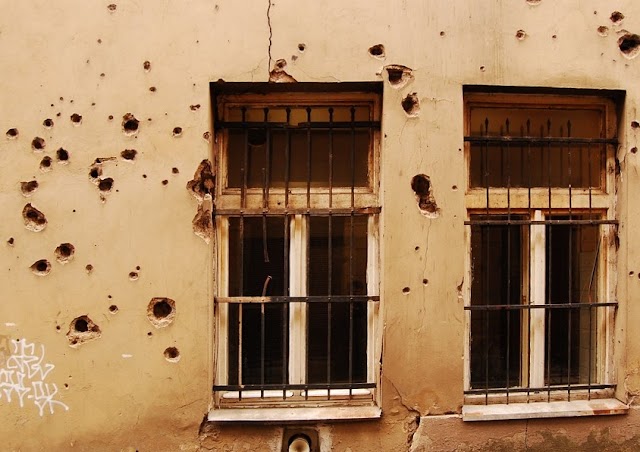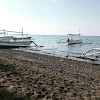Dubrovnik had left me a very good impression and Sarajevo awaits for an interesting experience the rest of the trip.
The journey passed through Bosnian vilage before reaching Mostar 3 hours after. I was a bit haunted seeing bullet holes from gunshots at the apartment complex in that town. It was half 6 pm when the bus reaching Mostar where there still sunlight made me able to see whats the town looklikes. The town was on hilly mountain and there were graveyards. I decided to skip Mostar from Dubrovnik though it's half way journey because I'll be there when Sarajevo done.
Arriving around 9 ish I asked the lady at the newsstand how to get to the tram heading to Baščaršija area.
It is considered to be the main street of Sarajevo and one of its most important landmarks.From behind 3 Bosnian boys approached and gave the direction. They were university student and it was such a welcoming and friendly gesture that they had showed. They walked me to the direction of tram stop so that I could catch the right tram to the hostel. When I waited the tram there was a girl that I asked how far to get to the place, she even gave me a little insight about Sarajevo. The tram looping back to town after reaching Barsacija, Maya accompanied me untill the right tram station even she was supposed to get off two stop before. There, the first hour in Sarajevo, I've met a friendly and welcoming Bosnian.
Arrived at Posilipo Hostel, Skenderija greeted me with the question where was I as my booking said I should arrived at 3pm and it was half ten.
I left Dubrovnik pretty late as the bus in Croatia leaving to neighbouring country at 3pm everyday.I didnt have any plan what to see in Bosnia but when I saw the brochure pinned up at he the board about 'Tunnel of Hope' tour I felt that I HAD to do that. Skenderija made this private tour on his own by his car and normally it only goes when his car is full.
At 10 in the morning he drove me to the 'Tunnel of Hope'. As mysterious and subtle the name suggested, it has become one of the most significant remembrance of the war. During the Siege of Sarajevo during Bosnian War between 1992 and 1995, the Sarajevo Tunnel was constructed by the besieged citizens of Sarajevo in order to link the city of Sarajevo, which was entirely cut-off by Serbian forces, with the supposedly neutral area at the Sarajevo airport set up by the United Nations.
The tunnel dug underneath the airport runway linked the Sarajevo neighborhoods of Dobrinja and Butmir.
Beginning in January 1993, the Sarajevo Tunnel was dug by Bosnian volunteers working in 8-hour shifts. It was was completed in mid-1993, which allowed food and humanitarian aid to come into the city, and people to get out. The tunnel was one of the major ways of bypassing the international arms embargo and providing the city defenders with weaponry. The tunnel was most famously used to transport the former Bosnian president in his wheelchair which was run on the railway of the tunnel. The 20 metres of tunnel that are left today now form part of a museum in Sarajevo.
In effect, the tunnel saved Sarajevo.
The house at the end of the tunnel was still present and had become the main museum.
It houses the war artefacts like guns, other weaponries, handmade oven,pictures and footage of the wars etc. Before the tour took place, a brief documentary slides show was screened to the audience from the basement of the Museum/house. A well documented war where it shows chronologically from the start to the construction of the tunnel. During the use of the tunnel, the besieged citizens walking pass by was served by the cup of water by and Old lady, the owner of the house. I was happy to know she still alive. And I even happier when I wandered around I saw her being greeted and captured by 2 Turkish gentlemen. I am glad I have a picture with her too.
She’s my Sarajevo Rose!
On the way back and back from The Tunnel, Skenderija shared the tourmented exeperience he had during war and he lost his uncle and a few of his extended family.
Noticing that I was really interested in war remnants, Skenderija drove to the part of the city where the traces still very obvious. He brought me to 'Snipper Alley' where it was the oldest Jewish Cemetery that the Serbian Army used it during the war. It's just as near as 500m from downtown Sarajevo where the snipper could perfectly aimed even as far as 1km so one could imagine the sheer anxiety at the place. Being at the site myself I could feel how devastated the war it was for the innocent souls of Bosnian. Sarajevo city itself geographically very strategic for invasion as it was a the base of valley. It was really sad seeing the war remnant, the graveyard beeing the familiar sight in Sarajevo and the torn building..
The night before I mingled with the guy I shared the dorm with in Posillipo Hostel Baščaršija .
Cillian, an Irish traveler was on his cycling tour across Europe and Middle east. He has been cycling since April and will continue till December when he reaches South of Egypt before catching a sail boat that he will work or co-pilot to India. That is a very exciting and one hell of a crazy journey. That night he finishes his beer while he shared his experience cycling through France-Germany-Hungary-Serbia-Bosnia. He camped most of the time. One night at the border of Serbian and Bosnian territory he stopped and made a camp in the wood when suddenly 2 Serbian officers came, torched and interrogated him. He was convicted as breaking the law but somehow being let go because he had paperwork sorted beforehand.
After the interrogation the officers left him and half an hour later they came back with bottles of beers hahaha! Camping wasn't so bad and lonely afterall.
That was one hella experience that we laughed till the other guest asked us to keep it down haha.
Sarajevo remains one of my most interesting places I’ve travelled so far. If you think of Istanbul is where East meet West, think again because Sarajevo have been a place where East meet west long before. It is where Christian, Jewish and Muslim co-existing centuries before the conflict during Balkan war in 92-95. I was a teenager when the war occurred and my mind wasn’t ready to comprehend and understand it. Now that I been here it refreshes my knowledge of the conflict during the Balkan War. I remember vividly the images in news in my home country the war had killed 12000 Bosnian and left kids orphaned. My country also sent humanitarian aids and some Sarajevan orphan kids being adopted as a foster kids in Malaysia. One of the place that I will set foot again someday.





0 Comments